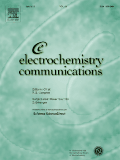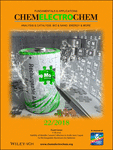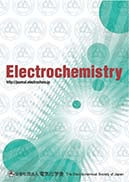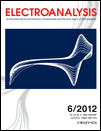
JOURNAL OF SOLID STATE ELECTROCHEMISTRY
Scope & Guideline
Unveiling the Science Behind Solid-State Innovations
Introduction
Aims and Scopes
- Solid-State Electrochemistry:
Research on the electrochemical properties and behaviors of solid-state materials, particularly in relation to energy storage devices like batteries and supercapacitors. - Electrode Materials Development:
Innovative synthesis and characterization of advanced electrode materials for applications in lithium-ion batteries, sodium-ion batteries, and supercapacitors. - Electrochemical Sensors:
Development of novel electrochemical sensors for environmental monitoring, health diagnostics, and food safety, utilizing various nanomaterials and composite materials. - Photoelectrochemical Applications:
Studies focused on photoelectrochemical processes, including water splitting for hydrogen production and dye-sensitized solar cells, emphasizing the integration of light-absorbing materials. - Corrosion Science:
Investigation into the electrochemical mechanisms of corrosion and the development of corrosion-resistant materials and coatings. - Electrochemical Energy Conversion:
Research on electrochemical systems for energy conversion processes, including fuel cells and electrolysis, aimed at improving efficiency and sustainability. - Computational Electrochemistry:
Utilization of computational methods to model and predict the electrochemical behavior of materials, aiding in the design of better electrochemical systems. - Environmental Electrochemistry:
Application of electrochemical methods for environmental remediation, including waste treatment and pollutant detection.
Trending and Emerging
- Nanostructured Materials for Energy Storage:
There is an increasing focus on the development and application of nanostructured materials, such as graphene and transition metal oxides, for enhancing the performance of batteries and supercapacitors. - Sustainable and Green Chemistry:
Research on environmentally friendly materials and processes, including the use of bio-derived materials and green synthesis methods, is becoming more prominent, aligning with global sustainability goals. - Hybrid Energy Storage Systems:
The exploration of hybrid systems that combine features of batteries and supercapacitors to achieve higher energy and power densities is gaining traction. - Solid-State Electrolytes:
A significant trend is the development of solid-state electrolytes for lithium-ion and sodium-ion batteries, focusing on improving safety and performance compared to liquid electrolytes. - Electrochemical Water Splitting:
Research on photoelectrochemical water splitting for hydrogen production is on the rise, driven by the quest for sustainable energy solutions. - Electrochemical Biosensors:
The field of biosensing is rapidly expanding, with a growing number of studies focusing on the development of electrochemical biosensors for medical diagnostics and environmental monitoring. - Computational and Theoretical Approaches:
The use of computational methods for predicting and modeling electrochemical behaviors and materials properties is increasingly prevalent, supporting experimental research. - Advanced Characterization Techniques:
Emerging techniques for material characterization, including in situ and operando methods, are becoming more common, allowing for better understanding of electrochemical processes.
Declining or Waning
- Traditional Battery Technologies:
Research on conventional battery technologies, such as lead-acid and nickel-cadmium batteries, appears to be waning in favor of more advanced materials and chemistries like lithium-ion and sodium-ion systems. - Basic Electrochemical Theory:
Papers centered solely on fundamental electrochemical theory without direct application or innovation have decreased. The journal is shifting towards applied research that has practical implications. - Corrosion Protection Coatings:
While corrosion science is still relevant, the specific focus on traditional protective coatings has diminished in favor of more innovative materials and methods, such as nanocomposites and hybrid systems. - Classic Voltammetric Techniques:
The use of classical voltammetric methods in isolation has seen a decline. There is a growing trend towards integrating these methods with advanced materials and multi-functional approaches. - Electrochemical Education:
While educational perspectives remain important, the volume of articles focusing on traditional electrochemical education practices has decreased, possibly due to a shift towards more technologically integrated teaching methods.
Similar Journals

ELECTROCHEMISTRY COMMUNICATIONS
Exploring the Frontiers of Electrochemistry with Impactful FindingsELECTROCHEMISTRY COMMUNICATIONS, published by ELSEVIER SCIENCE INC, is a leading journal in the field of electrochemistry, holding a prestigious position in the Q1 quartile since 2023. With an impact factor reflecting its esteemed reputation, the journal ranks #15 out of 60 in the Scopus Chemistry category for Electrochemistry, placing it in the 75th percentile. Since adopting an Open Access model in 2019, it has garnered widespread visibility and accessibility, enabling researchers and professionals to share groundbreaking findings and foster innovation. Covering a wide range of topics from fundamental electrochemical research to practical applications, ELECTROCHEMISTRY COMMUNICATIONS serves as a critical platform for disseminating knowledge and advancing the field. The journal's commitment to quality and relevance positions it as a vital resource for academics and practitioners striving to stay at the forefront of electrochemical science.

Electrochemical Society Interface
Empowering Innovation through Electrochemical InsightsElectrochemical Society Interface is a prominent journal within the field of electrochemistry, published by the Electrochemical Society Inc. The journal, carrying the ISSN 1064-8208 and E-ISSN 1944-8783, serves as a vital platform for researchers, professionals, and students alike, aiming to bridge the gap between cutting-edge research and practical applications in the electrochemical domain. With a convergence period spanning from 1992 to 2024, the journal enjoys a respectable ranking in the Q3 Quartile of the 2023 Electrochemistry category. Although it does not currently offer open access options, its articles provide valuable insights into various aspects of electrochemical research and technology, enhancing the scholarly communication in this important field. By maintaining high standards in research dissemination, Electrochemical Society Interface continues to foster innovation and contributes significantly to the developments in electrochemical processes and materials.

ChemElectroChem
Illuminating pathways to energy innovation and sustainability.ChemElectroChem is a premier open-access journal published by WILEY-V C H VERLAG GMBH, focusing on the interdisciplinary fields of catalysis and electrochemistry. Established in 2014 and actively publishing until 2024, this journal boasts an impressive reputation, currently ranked in the Q2 category for both catalysis and electrochemistry according to the 2023 metrics. With an Scopus ranking placing it in the 74th percentile for Electrochemistry and 61st for Chemical Engineering and Catalysis, ChemElectroChem serves as an essential platform for researchers, professionals, and students dedicated to advancing knowledge and fostering innovation in these critical scientific domains. Since its transition to open access in 2023, the journal aims to maximize the dissemination of cutting-edge research and facilitate the exchange of ideas among global scholars, thereby enhancing the accessibility and impact of high-quality science within the community. For those engaged in the ever-evolving conversations around energy storage, conversion processes, and sustainable solutions, ChemElectroChem is an invaluable resource.

Electrochemical Energy Reviews
Catalyzing Knowledge in Electrochemical Energy TechnologiesElectrochemical Energy Reviews, published by SpringerNature, serves as an essential platform for the dissemination of cutting-edge research in the fields of electrochemistry, material science, and energy engineering. With an impressive impact factor and ranked in the Q1 category across multiple disciplines including Chemical Engineering and Energy Technology, this journal highlights its commitment to advancing knowledge and innovation within the energy sector. Operating since 2018, the journal not only provides a valuable resource for researchers and professionals but also invites contributions from students and emerging scholars interested in the pivotal role of electrochemical processes in sustainable energy solutions. Published in Germany and widely accessible to the global research community, Electrochemical Energy Reviews is an indispensable reference for those keen on exploring the future of energy technologies.

Journal of Power Sources Advances
Connecting Researchers to the Future of EnergyJournal of Power Sources Advances, published by ELSEVIER, stands at the forefront of innovative research within the fields of Electrochemistry, Energy Engineering and Power Technology, and Materials Chemistry. Having established itself as an Open Access journal since 2020, it aims to disseminate knowledge rapidly and widely among researchers, professionals, and students interested in the latest advancements in power sources technology. With an impressive impact factor and recognition as a Q1 journal in 2023 across multiple categories, it addresses key challenges and innovations in energy generation, storage, and materials development. The journal's commitment to high-quality, peer-reviewed content fosters a vibrant community for discussing breakthroughs that hold the potential to transform energy systems globally. The journal operates out of the Netherlands, enhancing its global outreach, while its strong Scopus rankings highlight its influential role in driving research within its scope. Journal of Power Sources Advances is the pivotal resource for those dedicated to shaping the future of energy sustainability and technology.

ELECTROCHEMISTRY
Driving Breakthroughs in Energy and Materials ScienceELECTROCHEMISTRY is an esteemed journal published by the Electrochemical Society of Japan, dedicated to advancing the field of electrochemical science and technology. With an ISSN of 1344-3542 and an E-ISSN of 2186-2451, this journal has been providing a platform for scholarly communication since its inception in 1996, with a converged scope extending to 2024. As an Open Access publication since 2020, it facilitates the wide dissemination of research, fostering collaboration among researchers, professionals, and students alike. Currently positioned in Q3 of the electrochemistry category and ranking 52 out of 60 in Scopus, ELECTROCHEMISTRY is committed to publishing high-quality, peer-reviewed articles that explore novel electrochemical systems, applications, and methodologies. With its base in Tokyo, Japan, the journal serves a global audience, promoting cutting-edge research that drives innovation in energy, materials science, and analytical chemistry.

ELECTROANALYSIS
Transforming Knowledge into Electroanalytical SolutionsELECTROANALYSIS is a premier journal published by WILEY-V C H VERLAG GMBH that serves the dynamic field of analytical and electrochemistry. Established in 1989, this scholarly publication has successfully converged its focus to cover a wide array of topics including novel electrochemical methods, sensor technology, and environmental analysis, reflecting the latest advancements and trends in the field. With an impressive 2023 impact factor that places it in the Q2 quartile of Analytical Chemistry and Q3 quartile in Electrochemistry, the journal is recognized for its high-quality research and contributions. Its Scopus rankings further reinforce its credibility, standing at #46/156 in Analytical Chemistry and #26/60 in Electrochemistry. Although currently not offering Open Access, the journal remains a significant resource for researchers, professionals, and students keen to stay at the forefront of electroanalytical techniques. With a global readership, ELECTROANALYSIS continues to drive knowledge and innovation within the scientific community.

Analytical & Bioanalytical Electrochemistry
Bridging Disciplines Through Electrochemical InnovationAnalytical & Bioanalytical Electrochemistry is a pivotal journal dedicated to the advancement of research and innovation in the fields of analytical chemistry and electrochemistry. Published by the University of Tehran, Faculty of Chemistry, Center of Excellence in Electrochemistry, this journal has been contributing to the scientific community since its inception in 2009 and continues to be a critical platform through 2024. With an ISSN of 2008-4226, it focuses on a variety of topics including electrochemical sensors, bioanalytical techniques, and innovative methodologies in electrochemical analysis. Although it currently holds a Q4 quartile ranking in both analytical chemistry and electrochemistry categories, its unique insights and research findings are essential for advancing knowledge and fostering interdisciplinary collaboration within the scientific community. Researchers, professionals, and students engaged in these dynamic fields will find valuable resources and contribute to the ongoing discourse by publishing their work in this journal. We invite you to explore and engage with the diverse content that Analytical & Bioanalytical Electrochemistry offers to enhance your research and professional development.

JOURNAL OF THE ELECTROCHEMICAL SOCIETY
Pioneering Research in Materials Science and Renewable EnergyJOURNAL OF THE ELECTROCHEMICAL SOCIETY, published by the ELECTROCHEMICAL SOCIETY INC, is a leading peer-reviewed academic journal dedicated to advancing the field of electrochemistry and its myriad applications. With an ISSN of 0013-4651 and E-ISSN of 1945-7111, this esteemed journal has been a pivotal platform for research since its inception in 1948, with convergence periods allowing for a rich historical context of study through to 2024. Recognized for its high impact, it holds a noteworthy Q1 ranking in several categories including Condensed Matter Physics and Materials Chemistry, and it is Q2 ranked in both Electrochemistry and Renewable Energy. This journal features a range of articles that encompass both theoretical and experimental advancements, making it a crucial resource for researchers, professionals, and students keen on exploring cutting-edge developments in materials science, energy solutions, and sustainable technologies. Although it is not an open access journal, its rigorous standards ensure that published work significantly contributes to the body of knowledge within its fields, fostering innovative research and collaborative progress.

International Journal of Electrochemical Science
Unveiling cutting-edge electrochemical techniques and applications.International Journal of Electrochemical Science is a peer-reviewed journal dedicated to disseminating cutting-edge research in the field of electrochemistry. Published by Elsevier in Serbia, this journal serves as a vital platform for scientists and researchers to explore innovative electrochemical techniques, processes, and applications. With an ISSN of 1452-3981, it has been a respected source of scholarly articles since its inception in 2006 and continues to bridge the gap between theoretical advancements and practical implementations up until 2024. Notably, it holds a Q4 quartile ranking in the field of electrochemistry and ranks 41 out of 60 in the Scopus database, situating it within the 32nd percentile among its peers. The journal champions open academic discourse, contributing significantly to the advancement of knowledge in electrochemical sciences, making it an essential resource for researchers, professionals, and students alike who are striving towards new discoveries and innovations.